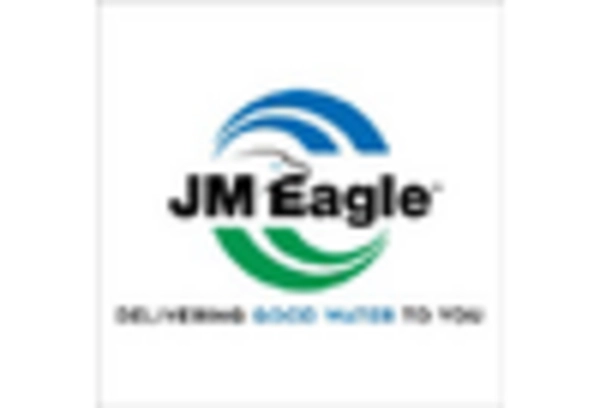Growth in the Construction Sector
The pvc pipes market is poised for growth, driven by the expansion of the construction sector in the United States. As residential and commercial construction projects surge, the demand for reliable plumbing and drainage systems increases. In 2025, the construction industry is expected to grow by 6%, leading to a corresponding rise in the need for PVC pipes. Their lightweight nature and ease of installation make them a favored option among contractors. Furthermore, the versatility of PVC pipes allows for their application in various construction projects, including housing, commercial buildings, and infrastructure. This growth in the construction sector is likely to have a positive impact on the pvc pipes market, as more builders recognize the benefits of using PVC.
Infrastructure Development Initiatives
The pvc pipes market is experiencing a notable boost due to extensive infrastructure development initiatives across the United States. Government investments in public works, including transportation, water supply, and sewage systems, are driving demand for durable and cost-effective piping solutions. In 2025, the U.S. government allocated approximately $1 trillion for infrastructure projects, which is expected to significantly enhance the pvc pipes market. The emphasis on modernizing aging infrastructure and expanding urban areas necessitates the use of high-quality materials, such as PVC, known for their longevity and resistance to corrosion. This trend indicates a robust growth trajectory for the pvc pipes market, as municipalities and private contractors increasingly opt for PVC pipes to meet their construction and renovation needs.
Environmental Regulations and Standards
The pvc pipes market is influenced by stringent environmental regulations and standards in the United States. As regulatory bodies impose guidelines to ensure the safety and sustainability of construction materials, the demand for compliant PVC pipes is on the rise. In 2025, the market is expected to see a shift towards eco-friendly manufacturing practices, with a projected increase of 7% in the adoption of sustainable materials. PVC pipes, which can be recycled and have a lower environmental impact compared to alternatives, are becoming increasingly attractive to builders and contractors. This regulatory landscape is likely to drive innovation and compliance within the pvc pipes market, as companies strive to meet the evolving standards set forth by environmental agencies.
Technological Innovations in Manufacturing
The pvc pipes market is experiencing a transformation due to technological innovations in manufacturing processes. Advances in production techniques, such as improved extrusion methods and enhanced quality control measures, are leading to the creation of superior PVC pipes. These innovations not only increase the efficiency of production but also enhance the performance characteristics of the pipes, such as flexibility and resistance to environmental stress. In 2025, the adoption of these advanced manufacturing technologies is expected to increase the overall market value of the pvc pipes market by approximately 5%. As manufacturers continue to invest in research and development, the quality and variety of PVC pipes available in the market will likely expand, catering to diverse consumer needs.
Rising Demand for Water Management Solutions
The pvc pipes market is likely to benefit from the increasing demand for efficient water management solutions in the United States. With growing concerns over water scarcity and the need for sustainable practices, municipalities are investing in advanced water distribution systems. PVC pipes, recognized for their lightweight and high durability, are becoming the preferred choice for water supply and drainage applications. In 2025, the market for water management solutions is projected to grow by 8%, further propelling the pvc pipes market. The ability of PVC pipes to withstand high pressure and their resistance to chemical corrosion make them ideal for various water management applications, thus enhancing their appeal in the pvc pipes market.

















Leave a Comment